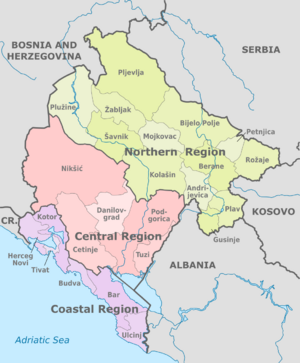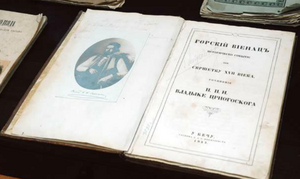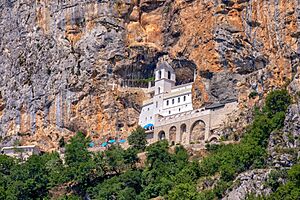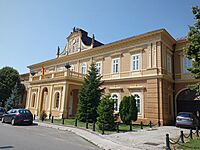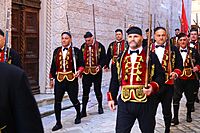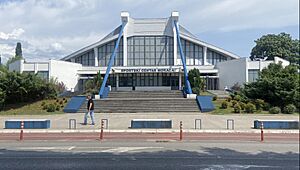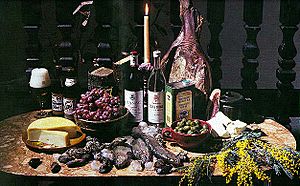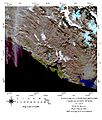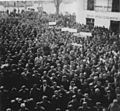Montenegro facts for kids
Quick facts for kids
Montenegro
|
|
|---|---|
|
Anthem:
Oj, svijetla majska zoro (English: "Oh, Bright Dawn of May") |
|
![Location of Montenegro (green)on the European continent (dark grey) — [Legend]](/images/thumb/b/b0/Europe-Montenegro.svg/350px-Europe-Montenegro.svg.png)
Location of Montenegro (green)
on the European continent (dark grey) — [Legend] |
|
| Capital and largest city
|
Podgorica 42°47′N 19°28′E / 42.783°N 19.467°E |
| Official languages | Montenegrin |
| Languages in official use | |
| Ethnic groups
(2023)
|
|
| Religion
(2023)
|
|
| Demonym(s) | Montenegrin |
| Government | Unitary parliamentary republic |
| Jakov Milatović | |
| Milojko Spajić | |
|
• President of the Parliament
|
Andrija Mandić |
| Legislature | Parliament |
| Establishment history | |
|
• Duklja
|
10th century |
|
• Zeta
|
1356 |
|
• Prince-Bishopric of Montenegro
|
1516 |
| 13 March 1852 | |
| 13 July 1878 | |
| 28 August 1910 | |
| 26 November 1918 | |
| 29 November 1945 | |
| 27 April 1992 | |
|
• Independence referendum
|
21 May 2006 |
| Area | |
|
• Total
|
13,812 km2 (5,333 sq mi) (156th) |
|
• Water (%)
|
2.6 |
| Population | |
|
• 2023 census
|
|
|
• Density
|
43.6/km2 (112.9/sq mi) (177th) |
| GDP (PPP) | 2023 estimate |
|
• Total
|
|
|
• Per capita
|
|
| GDP (nominal) | 2023 estimate |
|
• Total
|
|
|
• Per capita
|
|
| Gini (2020) | ▼ 32.9 medium |
| HDI (2022) | very high · 50th |
| Currency | Euro (€)a (EUR) |
| Time zone | UTC+1 (CET) |
|
• Summer (DST)
|
UTC+2 (CEST) |
| Calling code | +382 |
| ISO 3166 code | ME |
| Internet TLD | .me |
|
|
Montenegro is a country located in Southeastern Europe. It sits on the Balkan Peninsula. It has 25 areas called municipalities. About 633,000 people live there in an area of 13,812 square kilometers (5,333 sq mi).
Montenegro shares borders with Bosnia and Herzegovina to the northwest and Serbia to the northeast. To the east, it borders Kosovo, and to the southeast, Albania. Croatia is to the west. It also has a coastline along the Adriatic Sea in the southwest.
The capital and largest city is Podgorica. Cetinje is known as the Old Royal Capital and is an important cultural center. Montenegro is a member of many international groups. These include the United Nations, NATO, and the World Trade Organization. It is also working to join the European Union.
Contents
A Quick Look at Montenegro's Past
Before the 6th and 7th centuries, people called Illyrians lived in the area now known as Montenegro. Later, Slavic peoples arrived.
In the 14th and 15th centuries, a state called the Principality of Zeta grew strong. The name Montenegro was first used in the late 15th century. For a long time, parts of southern Montenegro were ruled by the Venetian Republic.
After being under the Ottoman Empire, Montenegro gained some freedom in 1696. It was first led by religious leaders, then by princes. In 1878, other powerful countries officially recognized Montenegro's independence.
In 1910, Montenegro became a kingdom. After World War I, it joined Yugoslavia. When Yugoslavia broke up, Montenegro formed a federation with Serbia. In June 2006, Montenegro voted to become fully independent. This created Montenegro and Serbia as separate countries today.
Exploring Montenegro's Geography
Montenegro is located between 41° and 44°N latitude and 18° and 21°E longitude. It borders Croatia, Bosnia and Herzegovina, Serbia, Kosovo, and Albania.
The country has high mountains along its borders with Serbia, Kosovo, and Albania. It also has a narrow coastal plain along the Adriatic Sea. This plain is only about 1.5 to 6 kilometers (1 to 4 miles) wide. In the north, mountains like Mount Lovćen and Mount Orjen meet the Bay of Kotor.
Montenegro has a large Karst region. This area is mostly 1,000 meters (3,300 feet) above sea level. Some parts, like Mount Orjen, rise to 2,000 meters (6,600 feet). The Zeta River valley is the lowest part of this region.
The mountains in Montenegro are very rugged. Many peaks are over 2,000 meters (6,600 feet) high. Bobotov Kuk in the Durmitor mountains is one of the highest, at 2,522 meters (8,274 feet).
Here are some interesting facts about Montenegro's geography:
- Longest beach: Velika Plaža, Ulcinj – 13,000 meters (8.1 miles) long.
- Highest peak: Zla Kolata, Prokletije at 2,535 meters (8,317 feet).
- Largest lake: Skadar Lake – 391 square kilometers (151 sq mi) in surface area.
- Deepest canyon: Tara River Canyon – 1,300 meters (4,300 feet) deep.
- Biggest bay: Bay of Kotor.
Amazing Plants and Animals
Montenegro is a "hot-spot" for biological diversity. This means it has many different kinds of plants and animals. Its varied landscape, climate, and location help create this rich natural world. Montenegro has the highest number of species per area unit in Europe.
- Freshwater Algae: Over 1,200 types of freshwater algae have been found.
- Vascular Flora: There are 3,250 species of plants with vascular systems. About 392 of these are endemic to the Balkans, meaning they are found only there.
- Marine Life:
- 354 species of marine molluscs live in Montenegro's waters.
- The Adriatic Sea near Montenegro has 117 families of marine fish. About 40,742 marine fish species have been recorded.
- Lake Skadar: This lake is very important for freshwater fish. It has 40 species, including eels and shad that travel between the sea and fresh water.
- Amphibians and Reptiles: There are 56 species of amphibians and reptiles. The mountain regions of Lovćen and Prokletije are especially rich in these animals.
- Birds: Out of 526 European bird species, 333 are regularly seen in Montenegro. 204 of these species nest in the country.
How Montenegro is Governed
Montenegro is a parliamentary representative democratic republic. This means its government is chosen by the people.
The President's Role
The President of Montenegro is the head of state. People vote directly for the President every five years. The President represents Montenegro to other countries. They also sign laws, call elections, and suggest people for important government jobs. The President's official home is in Cetinje.
The Government and Prime Minister
The Government of Montenegro is the executive branch. This means they carry out the laws. The government is led by the Prime Minister. The Prime Minister has the most political power in Montenegro.
The Parliament's Work
The Parliament of Montenegro is the country's one-chamber legislature. It is located in Podgorica. The Parliament has several important jobs:
- It appoints the government.
- It passes laws.
- It checks the work of the government.
- It approves the country's budget.
There are currently 81 members of Parliament, called Deputies. They are elected based on how many votes their party gets.
Montenegro's Local Areas
Montenegro is divided into twenty-five areas called municipalities (opština). Each municipality can have many cities and towns.
For statistical reasons, Montenegro is also grouped into regions, but these don't have administrative power.
- Northern Region
| Municipality | Area | Population | ||
|---|---|---|---|---|
| Km² | Rank | Total | Rank | |
| Andrijevica | 283 | 12 | 5,117 | 10 |
| Berane | 544 | 6 | 28,305 | 3 |
| Bijelo Polje | 924 | 2 | 46,676 | 1 |
| Gusinje | 486 | 8 | 13,108 | 6 |
| Kolašin | 897 | 3 | 8,420 | 8 |
| Mojkovac | 367 | 11 | 8,669 | 7 |
| Petnjica | 173 | 13 | 6,686 | 9 |
| Plav | 486 | 7 | 13,549 | 5 |
| Plužine | 854 | 4 | 3,286 | 12 |
| Pljevlja | 1,346 | 1 | 31,060 | 2 |
| Rožaje | 432 | 10 | 23,312 | 4 |
| Šavnik | 553 | 5 | 2,077 | 13 |
| Žabljak | 445 | 9 | 3,599 | 11 |
- Central Region
| Municipality | Area | Population | ||
|---|---|---|---|---|
| Km² | Rank | Total | Rank | |
| Cetinje | 899 | 3 | 16,757 | 4 |
| Danilovgrad | 501 | 4 | 17,678 | 3 |
| Nikšić | 2,065 | 1 | 72,824 | 2 |
| Podgorica | 1,399 | 2 | 187,085 | 1 |
| Tuzi | 236 | 5 | 12,096 | 5 |
- Coastal Region
| Municipality | Area | Population | ||
|---|---|---|---|---|
| Km² | Rank | Total | Rank | |
| Bar | 598 | 1 | 42,368 | 1 |
| Budva | 122 | 5 | 19,170 | 5 |
| Herceg Novi | 235 | 4 | 30,992 | 2 |
| Kotor | 335 | 2 | 22,799 | 3 |
| Tivat | 46 | 6 | 14,111 | 6 |
| Ulcinj | 255 | 3 | 20,265 | 4 |
Montenegro's Economy
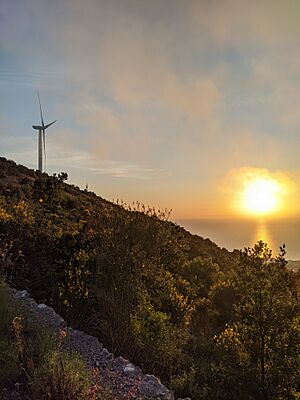
Montenegro's economy mainly relies on services. It is changing to a market economy.
Tourism is very important for Montenegro. In 2022, over 2.1 million visitors came to the country. Most foreign visitors are from nearby countries like Serbia, Bosnia and Herzegovina, Kosovo, and Russia.
The Montenegrin Adriatic coast is 295 kilometers (183 miles) long. It has 72 kilometers (45 miles) of beaches and many old towns. Popular beaches include Jaz Beach, Mogren Beach, and Velika Plaža. Famous old towns are Herceg Novi, Kotor, and Budva.
People and Languages in Montenegro
In 2023, the census reported 623,633 citizens. Montenegro is a multiethnic state. This means many different ethnic groups live there. No single group forms a majority.
- Montenegrins make up 41.1% of the population.
- Serbs are 32.9%.
- Bosniaks are 9.45%.
- Albanians are 4.99%.
- Russians are 2.01%.
There are also many other groups, like Romani people and Croats.
Montenegro has a very low Global Hunger Index (GHI) score. This means it is one of 22 countries with good food security.
Languages Spoken in Montenegro
The official language in Montenegro is Montenegrin. However, Serbian, Bosnian, Albanian, and Croatian are also officially used.
Montenegrin, Serbian, Bosnian, and Croatian are very similar. People who speak one can usually understand the others. Serbian is the most spoken language, with 43.18% of people saying it's their native language. 34.52% speak Montenegrin.
Religions in Montenegro
Eastern Orthodox Christianity is the main religion in Montenegro. About 71.1% of the people follow this religion.
Islam is the second largest religion. About 19% of the population practices Islam. Montenegro has one of the highest percentages of Muslims in Europe. Some Albanians in Montenegro are Catholics, but most are Sunni Muslims.
Montenegro's Culture
Montenegrin culture has been shaped by many influences. These include Orthodox, Ottoman (Turkish), Slavic, Central European, and Adriatic cultures.
Montenegro has many important cultural and historical places. These include old buildings from Romanesque, Gothic, and Baroque times. The coastal area is known for its religious sites. Examples are the Cathedral of Saint Tryphon in Kotor and Our Lady of the Rocks. Many medieval monasteries have beautiful old paintings called frescoes.
A special part of Montenegrin culture is the idea of Čojstvo i Junaštvo. This means "Humaneness and Gallantry." The traditional folk dance is the Oro, or "eagle dance." Dancers form circles and sometimes human pyramids.
Sports in Montenegro
Sports in Montenegro mostly focus on team sports. These include water polo, football, basketball, handball, and volleyball. Other popular sports are boxing, tennis, and judo.
Water polo is the most popular sport and is considered the national sport. The Montenegro men's national water polo team is one of the best in the world. They won gold medals in the 2008 European Championship and the 2009 FINA World League. The team PVK Primorac from Kotor also won the European championship in 2009.
Football is the second most popular sport. The Montenegro national football team was formed in 2006. They played in the playoffs for the UEFA Euro 2012. The Montenegro national basketball team has also performed well.
For women's sports, the Montenegro women's national handball team is very successful. They won Montenegro's first Olympic medal, a silver, at the 2012 Summer Olympics. They also became European champions in 2012.
Delicious Montenegrin Food
Montenegrin food has been influenced by many cultures. Early influences came from the Levant and Turkey. You can find dishes like sarma, musaka, and burek. Turkish sweets like baklava are also popular.
Hungarian cuisine brought dishes like stews. Central European cuisine influenced the love for crêpes, doughnuts, and various breads.
Montenegrin food also changes depending on the region. The coastal area has Mediterranean cuisine. This means seafood is a common dish. The food along the Adriatic coast has been greatly influenced by Italian cooking.
Images for kids
-
Zla Kolata, highest point of Montenegro
-
The Eurasian brown bear, a protected species in Montenegro.
-
The common bottlenose dolphin is often seen in the Bay of Kotor.
-
Royal family of Montenegro: King Nicholas I with his wife, sons, daughters, grandchildren and sons- and daughters-in-law
-
Captured ships of the Yugoslav Navy, Bay of Kotor 1941
-
Opening of Belgrade–Bar railway. Construction of the line started in the 1950s and completed in 1976. The line was opened in 1976 by the Yugoslavian President Josip Broz Tito
-
Map of the disintegration of Yugoslavia until 2008
See also
 In Spanish: Montenegro para niños
In Spanish: Montenegro para niños




